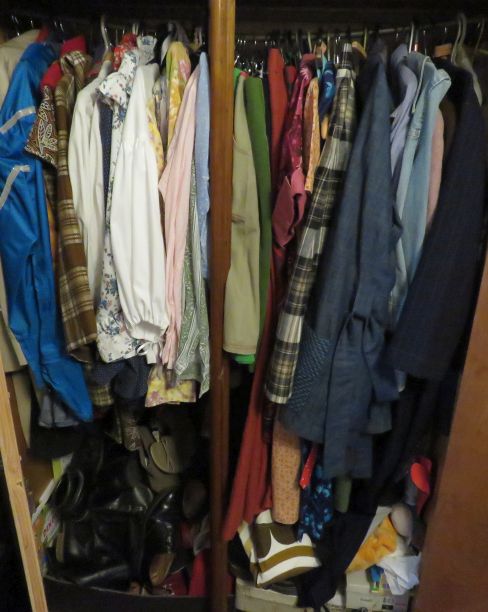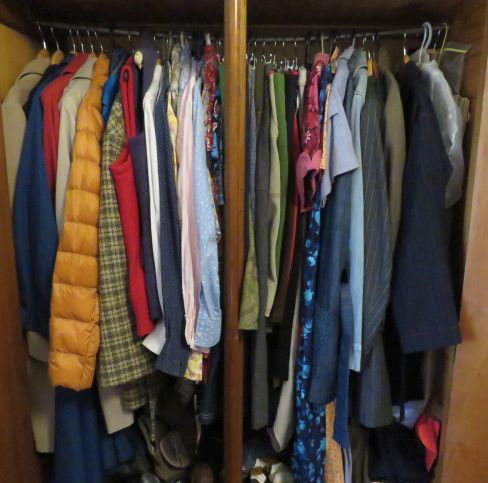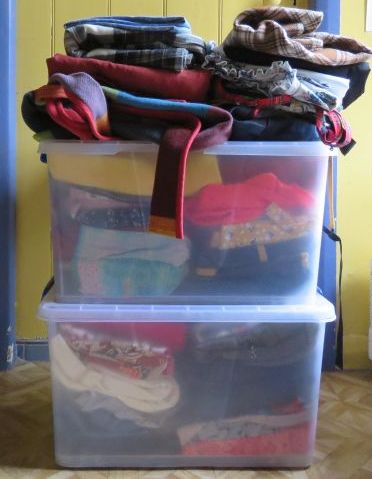The Wardrobe and the Zero Waste Archive

On a whim, I cleaned out my wardrobe yesterday.
Actually, what happened was, I pulled out a garment to wear and saw an insect (not a moth) crawling on it. That galvanized me into action!
I confess I own a large number of clothes. Most are homemade, with a sprinkling of op shop and RTW. I blush to report that my wardrobe is so full that coat hangers are barely required – the clothes themselves hold everything vertical. The rail is bowing heavily but appears to be holding.

So I took everything out and went through it, my children chose what they wanted, I put some things aside to alter (I’ve gone up at least a size in the past two years; pandemic not to blame), some went to the zero waste archive (keep reading for more on this) and the remainder will be donated. I was realistic but not especially ruthless.
I liberated an astonishing 26 coat hangers! And yet, the wardrobe still looks reasonably full.

A fair few zero waste samples have absorbed themselves into my wardrobe, but not all have found their place there. These went back into the zero waste archive.
I keep an archive of samples from zero waste patterns I’ve published. They’re only the ones that fit me – the models keep the others. Apart from the ones in the Zero Waste Sewing book, I’ve published 14 pdfs, some free ones on this website, and some in my current project A Year of Zero Waste Sewing.

The clothes at the top are kept in a cloth bag.
The zero waste archive is more useful than I thought it would be – I’m so glad I have it. So handy to check things if needed, refer to fit, build on an idea, show-and-tell at talks, etc. I also wear them sometimes.
I’ve never worked for a designer who kept an archive. They all sold their samples at the end of selling that season’s range, to recoup the cost. I think storage space was also an issue, too – after a couple of decades in business, an archive can get pretty big and be expensive to manage. They never appeared to regret selling their samples, although I never specifically asked them. They did archive patterns, sketches, lookbooks, etc though, so theoretically they could reproduce them.
Big fashion houses such as Dior keep archives. It’s considered essential for a brand’s history and identity, current inspiration, retrospective exhibitions and so on.
Are you a designer with an archive? Or have you worked in one? Have you visited an archive? Please leave a comment!
Cheers!
My wardrobe looks very similar to your ‘before’ shot – but with much more blue! My rail isn’t high enough for full length dresses so they go in my husband’s (bigger) wardrobe (his job requires suits). I’m not someone who has ‘summer’ and ‘winter’ clothing and swaps them in and out of storage. But I have considered this as a possibility when trying to squeeze in another shirt!
Ah, I confess I, too, store stuff in Mr H’s wardrobe! He doesn’t use all the space so I requisitioned some. I didn’t even look in that wardrobe when I had a clear out. Another day!
Btw, Marie Kondo reckons it’s better to store everything together rather than rotate summer and winter clothes, so I’m going with that. 🙂
I have done the summer- winter seal my entire life. It forces a bi-annual thinning of garments that don’t fit, or need repair or re-fashioning. It keeps my small closet manageable. Plus, in my climate, it’s utterly useless to keep sleeveless summer blouses hanging in my closet when it’s below zero (Celsius, and often below zero Fahrenheit!) or have heavy wool sweaters taking up space when it’s 35°C with 95 % humidity.
Sounds like you have good system going there. Gee, you have some temperature extremes!